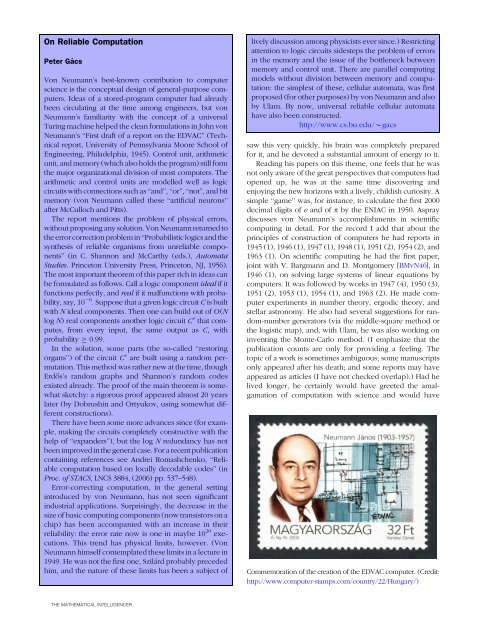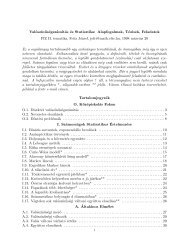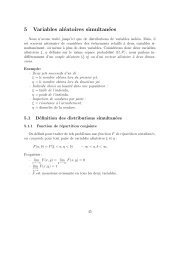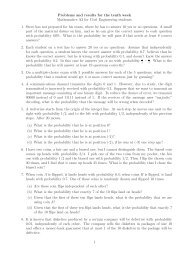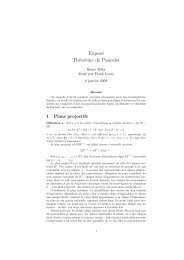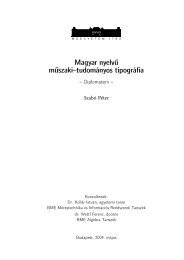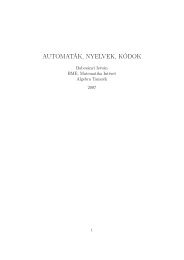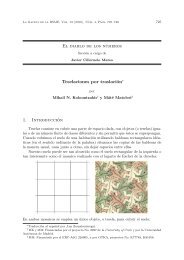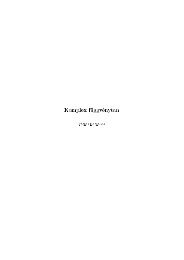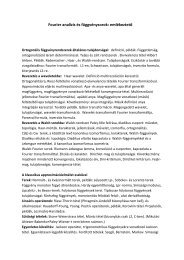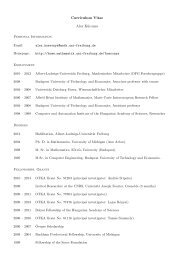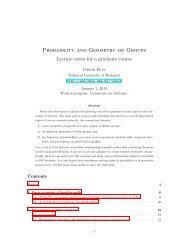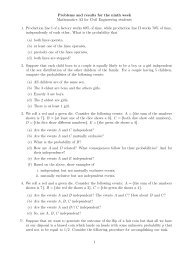John von Neumann, the Mathematician
John von Neumann, the Mathematician
John von Neumann, the Mathematician
Create successful ePaper yourself
Turn your PDF publications into a flip-book with our unique Google optimized e-Paper software.
On Reliable Computation<br />
Peter Gács<br />
Von <strong>Neumann</strong>’s best-known contribution to computer<br />
science is <strong>the</strong> conceptual design of general-purpose computers.<br />
Ideas of a stored-program computer had already<br />
been circulating at <strong>the</strong> time among engineers, but <strong>von</strong><br />
<strong>Neumann</strong>’s familiarity with <strong>the</strong> concept of a universal<br />
Turing machine helped <strong>the</strong> clean formulations in <strong>John</strong> <strong>von</strong><br />
<strong>Neumann</strong>’s ‘‘First draft of a report on <strong>the</strong> EDVAC’’ (Technical<br />
report, University of Pennsylvania Moore School of<br />
Engineering, Philadelphia, 1945). Control unit, arithmetic<br />
unit, and memory (which also holds <strong>the</strong> program) still form<br />
<strong>the</strong> major organizational division of most computers. The<br />
arithmetic and control units are modelled well as logic<br />
circuits with connections such as ‘‘and’’, ‘‘or’’, ‘‘not’’, and bit<br />
memory (<strong>von</strong> <strong>Neumann</strong> called <strong>the</strong>se ‘‘artificial neurons’’<br />
after McCulloch and Pitts).<br />
The report mentions <strong>the</strong> problem of physical errors,<br />
without proposing any solution. Von <strong>Neumann</strong> returned to<br />
<strong>the</strong> error correction problem in ‘‘Probabilistic logics and <strong>the</strong><br />
syn<strong>the</strong>sis of reliable organisms from unreliable components’’<br />
(in C. Shannon and McCarthy (eds.), Automata<br />
Studies. Princeton University Press, Princeton, NJ, 1956).<br />
The most important <strong>the</strong>orem of this paper rich in ideas can<br />
be formulated as follows. Call a logic component ideal if it<br />
functions perfectly, and real if it malfunctions with probability,<br />
say, 10 -6 . Suppose that a given logic circuit C is built<br />
with N ideal components. Then one can build out of O(N<br />
log N) real components ano<strong>the</strong>r logic circuit C 0 that computes,<br />
from every input, <strong>the</strong> same output as C, with<br />
probability C 0.99.<br />
In <strong>the</strong> solution, some parts (<strong>the</strong> so-called ‘‘restoring<br />
organs’’) of <strong>the</strong> circuit C 0 are built using a random permutation.<br />
This method was ra<strong>the</strong>r new at <strong>the</strong> time, though<br />
Erd}os’s random graphs and Shannon’s random codes<br />
existed already. The proof of <strong>the</strong> main <strong>the</strong>orem is somewhat<br />
sketchy: a rigorous proof appeared almost 20 years<br />
later (by Dobrushin and Ortyukov, using somewhat different<br />
constructions).<br />
There have been some more advances since (for example,<br />
making <strong>the</strong> circuits completely constructive with <strong>the</strong><br />
help of ‘‘expanders’’), but <strong>the</strong> log N redundancy has not<br />
been improved in <strong>the</strong> general case. For a recent publication<br />
containing references see Andrei Romashchenko, ‘‘Reliable<br />
computation based on locally decodable codes’’ (in<br />
Proc. of STACS, LNCS 3884, (2006) pp. 537–548).<br />
Error-correcting computation, in <strong>the</strong> general setting<br />
introduced by <strong>von</strong> <strong>Neumann</strong>, has not seen significant<br />
industrial applications. Surprisingly, <strong>the</strong> decrease in <strong>the</strong><br />
size of basic computing components (now transistors on a<br />
chip) has been accompanied with an increase in <strong>the</strong>ir<br />
reliability: <strong>the</strong> error rate now is one in maybe 10 20 executions.<br />
This trend has physical limits, however. (Von<br />
<strong>Neumann</strong> himself contemplated <strong>the</strong>se limits in a lecture in<br />
1949. He was not <strong>the</strong> first one, Szilárd probably preceded<br />
him, and <strong>the</strong> nature of <strong>the</strong>se limits has been a subject of<br />
THE MATHEMATICAL INTELLIGENCER<br />
lively discussion among physicists ever since.) Restricting<br />
attention to logic circuits sidesteps <strong>the</strong> problem of errors<br />
in <strong>the</strong> memory and <strong>the</strong> issue of <strong>the</strong> bottleneck between<br />
memory and control unit. There are parallel computing<br />
models without division between memory and computation:<br />
<strong>the</strong> simplest of <strong>the</strong>se, cellular automata, was first<br />
proposed (for o<strong>the</strong>r purposes) by <strong>von</strong> <strong>Neumann</strong> and also<br />
by Ulam. By now, universal reliable cellular automata<br />
have also been constructed.<br />
http://www.cs.bu.edu/*gacs<br />
saw this very quickly, his brain was completely prepared<br />
for it, and he devoted a substantial amount of energy to it.<br />
Reading his papers on this <strong>the</strong>me, one feels that he was<br />
not only aware of <strong>the</strong> great perspectives that computers had<br />
opened up, he was at <strong>the</strong> same time discovering and<br />
enjoying <strong>the</strong> new horizons with a lively, childish curiosity. A<br />
simple ‘‘game’’ was, for instance, to calculate <strong>the</strong> first 2000<br />
decimal digits of e and of p by <strong>the</strong> ENIAC in 1950. Aspray<br />
discusses <strong>von</strong> <strong>Neumann</strong>’s accomplishments in scientific<br />
computing in detail. For <strong>the</strong> record I add that about <strong>the</strong><br />
principles of construction of computers he had reports in<br />
1945 (1), 1946 (1), 1947 (1), 1948 (1), 1951 (2), 1954 (2), and<br />
1963 (1). On scientific computing he had <strong>the</strong> first paper,<br />
joint with V. Bargmann and D. Montgomery [BMvN46], in<br />
1946 (1), on solving large systems of linear equations by<br />
computers. It was followed by works in 1947 (4), 1950 (3),<br />
1951 (2), 1953 (1), 1954 (1), and 1963 (2). He made computer<br />
experiments in number <strong>the</strong>ory, ergodic <strong>the</strong>ory, and<br />
stellar astronomy. He also had several suggestions for random-number<br />
generators (via <strong>the</strong> middle-square method or<br />
<strong>the</strong> logistic map), and, with Ulam, he was also working on<br />
inventing <strong>the</strong> Monte-Carlo method. (I emphasize that <strong>the</strong><br />
publication counts are only for providing a feeling. The<br />
topic of a work is sometimes ambiguous; some manuscripts<br />
only appeared after his death; and some reports may have<br />
appeared as articles (I have not checked overlap).) Had he<br />
lived longer, he certainly would have greeted <strong>the</strong> amalgamation<br />
of computation with science and would have<br />
Commemoration of <strong>the</strong> creation of <strong>the</strong> EDVAC computer. (Credit:<br />
http://www.computer-stamps.com/country/22/Hungary/)


